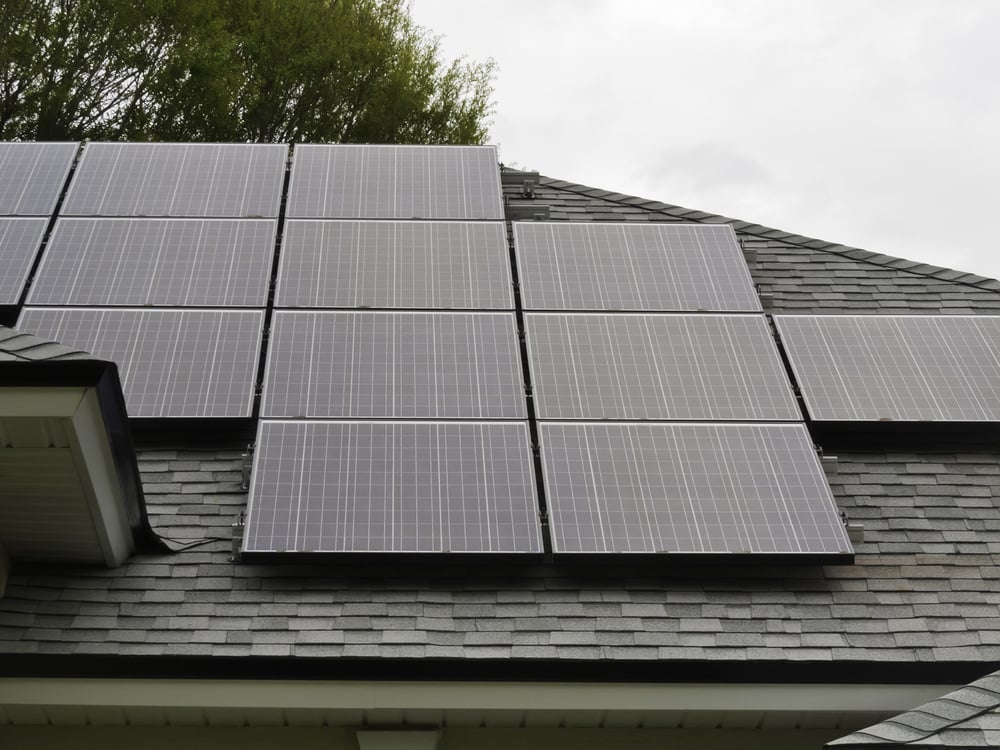Environmental Impact of Solar Power: A Deep Dive into How Solar Benefits the Planet
When it comes to clean energy, solar power is a game-changer. Imagine tapping into the sun’s energy, which is available in endless supply, to power...
6 min read
Peter Swenson : Oct 28, 2024 4:54:01 PM

Switching to solar power is a powerful decision for both your wallet and the environment. But let’s face it—while solar can save you money in the long run, the upfront costs can be daunting. Thankfully, there’s good news. Many incentives and financing options are available that can significantly reduce the cost of going solar, making it an option for homeowners with a range of budgets.
In this guide, we’ll break down the most popular solar incentives, including federal and state benefits, and explore financing options to help make your transition to solar as smooth and affordable as possible. Whether you’re just beginning your solar journey or ready to make the leap, understanding these incentives and financing routes can maximize your savings and make solar an achievable investment.
Let’s start with the biggest solar incentive in the U.S.: the Federal Investment Tax Credit (ITC). Also known as the Federal Solar Tax Credit, the ITC is a game-changer when it comes to lowering the initial cost of a solar installation.
The ITC allows you to deduct a significant percentage of the cost of installing a solar energy system from your federal taxes. This credit is available for both residential and commercial solar installations, making it one of the most popular and impactful incentives for going solar.
Current Rate: As of now, the ITC offers a 30% tax credit on the total cost of your solar installation. For example, if your system costs $20,000, you can receive a $6,000 credit on your federal taxes.
Applicable Costs: The ITC applies to more than just the panels themselves. You can also claim the credit on costs related to installation, labor, and equipment like inverters and wiring.
The ITC is a tax credit, not a rebate, which means it reduces the amount of taxes you owe rather than providing a direct cash refund. Here’s how it works:
Calculate Your Total Installation Cost: Include equipment, labor, and any additional installation fees.
Apply the ITC Percentage: Multiply the total cost by 30% to determine the credit you’ll receive.
Claim on Your Taxes: When you file your federal taxes, you’ll claim the credit using IRS Form 5695. This credit directly reduces what you owe.
Benefits: The ITC can provide thousands of dollars in tax relief, making solar installations much more affordable.
Limitations: This credit only applies if you owe federal income taxes. If you owe less than the credit, the unused amount can roll over to the next tax year.
The ITC is a massive financial boost, making it more affordable to go solar and enjoy long-term savings.
In addition to the federal ITC, many states offer their own incentives to encourage solar adoption. While these vary widely depending on your location, they can provide additional savings that make going solar even more attractive. Let’s go over the most common state-level incentives.
State rebates are direct discounts on your solar installation cost, and they work similarly to rebates you might receive on household appliances.
How They Work: After installing your solar system, you apply for a rebate through your state or local program. If approved, you receive a cash rebate that reduces your net cost.
Examples: In states like New York, California, and Massachusetts, rebate programs can provide thousands of dollars in savings, often reducing installation costs by 10-20%.
SRECs are incentives that reward you for generating clean energy, specifically by issuing certificates based on the amount of electricity your solar system produces.
How They Work: For each megawatt-hour (MWh) of solar electricity generated, you earn an SREC, which you can sell to utility companies. Many states require utility companies to meet certain clean energy standards, so they’ll buy SRECs to help meet these goals.
Benefits: SRECs can be a substantial income stream, especially in states like New Jersey, Massachusetts, and Maryland, where utilities pay higher rates for these certificates.
Example: If your system produces 5 MWh per year, you could earn 5 SRECs. Depending on market value, these can be worth hundreds of dollars annually.
Performance-Based Incentives (PBIs) pay you for the actual energy your system produces, usually measured per kilowatt-hour (kWh).
How They Work: PBIs pay you based on the amount of electricity your solar system generates, with payments made over time. Unlike rebates, PBIs are performance-based, meaning the more energy you produce, the more you earn.
Example Programs: In states like Texas and Colorado, utilities offer PBIs to homeowners with solar panels. Some programs pay up to $0.02 to $0.10 per kWh generated.
These state incentives, when combined with the federal ITC, can reduce your solar investment significantly, helping you recover your upfront costs faster and start reaping the benefits sooner.
When it comes to paying for your solar system, there are four primary financing options: cash purchase, solar loans, leases, and Power Purchase Agreements (PPAs). Let’s break down each option and help you find the one that fits your budget and goals.
Purchasing a solar system with cash is the simplest financing option and offers some distinct advantages.
How It Works: You pay for the entire system upfront, which means you own the equipment outright and don’t have to worry about monthly payments.
Benefits: Cash purchases generally offer the best long-term savings because you avoid interest fees, and you’re eligible for all available incentives, including the ITC, state rebates, and SRECs.
Considerations: While cash purchases provide the highest ROI, they require a large upfront investment, which can be a barrier for some homeowners.
Solar loans are similar to home improvement loans and are one of the most popular ways to finance a solar installation.
How They Work: With a solar loan, you borrow money to pay for the system upfront and then repay the loan in monthly installments, usually with interest.
Benefits: Solar loans make it possible to go solar without a large upfront payment. You still own the system, so you’re eligible for tax credits and other incentives, and you can start saving on electricity right away.
Considerations: Loan terms and interest rates vary, so it’s essential to shop around. Some solar loans may have higher interest rates, which can impact your long-term savings.
Types of Solar Loans:
With a solar lease, you don’t own the system but essentially “rent” it for a fixed monthly payment.
How It Works: In a lease agreement, the solar company owns the system and handles maintenance and repairs. You pay a fixed monthly rate to use the solar power generated.
Benefits: Solar leases have low to no upfront costs, and they offer immediate savings on energy bills. Leasing is also ideal if you don’t want the responsibility of system ownership or maintenance.
Considerations: Because you don’t own the system, you’re not eligible for tax credits or state incentives. Long-term savings are typically lower than with cash purchases or loans.
Power Purchase Agreements (PPAs) are similar to leases but with a key difference: instead of paying a flat rate, you pay for the electricity the system generates.
How It Works: In a PPA, you agree to buy the electricity generated by the solar panels at a set price per kWh. This rate is usually lower than your utility’s rate, providing immediate savings.
Benefits: PPAs offer low or no upfront costs, and you pay only for the energy you use. They’re a great option if you want to save on electricity without owning the system.
Considerations: Like leases, PPAs don’t qualify for tax credits or other ownership-based incentives. Additionally, you won’t have as much control over the system as you would with ownership.
Now that you know the options, how do you choose the best one? Let’s go over a few factors that can help guide your decision:
Cash Purchase: Ideal if you have the funds available and want to maximize long-term savings.
Solar Loan: Suitable if you prefer to own the system but don’t have the funds to pay upfront.
Lease or PPA: Great options for those who want immediate savings without a large initial investment.
Cash Purchase: Offers the highest long-term savings and ROI because there are no interest payments.
Solar Loan: Provides good long-term savings, though some will go toward interest payments.
Lease or PPA: These offer savings on your utility bills but typically have lower lifetime savings compared to ownership options.
Solar Loan: Monthly payments can be affordable if you secure a low-interest rate. Look for loan terms that match your budget.
Lease or PPA: These options are often the most affordable monthly, with little to no upfront cost, making them attractive for those on a tight budget.
Cash Purchase and Solar Loan: You’re responsible for system maintenance, which can be a pro or a con, depending on your preference.
Lease and PPA: The solar company owns the system and typically handles all maintenance and repairs, which is convenient if you prefer a hands-off approach.
Cash Purchase and Solar Loan: Both of these options allow you to claim tax credits, rebates, and other incentives, maximizing your financial benefits.
Lease and PPA: Since you don’t own the system, you’re not eligible for ownership-based incentives, which limits your financial benefits.
Switching to solar is an investment, but it doesn’t have to break the bank. With the help of federal and state incentives, along with a range of financing options, going solar is more affordable and accessible than ever before. By taking advantage of incentives like the federal ITC and exploring different financing routes, you can find the setup that best fits your budget, needs, and long-term savings goals.
Here’s a quick recap of what we’ve covered:
Federal Incentives: The federal ITC provides a 30% tax credit, reducing the upfront cost of your solar system.
State Incentives: Rebates, SRECs, and performance-based incentives can lower costs and add extra income over time.
Financing Options: From cash purchases to solar loans, leases, and PPAs, each financing option offers different benefits based on your financial goals and lifestyle.
Going solar is a decision that not only benefits your wallet but also helps the environment. So, don’t miss out on the incentives and financing options that can make solar an affordable reality for you. Take the time to explore the best incentives and financing options in your area, and start saving with solar!

When it comes to clean energy, solar power is a game-changer. Imagine tapping into the sun’s energy, which is available in endless supply, to power...

When you think about going solar, you probably picture panels on your roof soaking up sunlight and turning it into electricity to power your home....

So you’re thinking about going solar—great choice! Solar energy is a fantastic way to lower your bills, reduce your carbon footprint, and gain some...